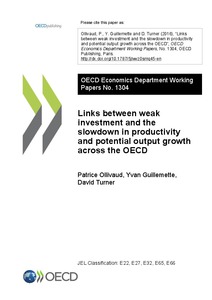Links between weak investment and the slowdown in productivity and potential output growth across the OECD
"The OECD framework for estimating potential output is combined with previous OECD empirical research to analyse the causes of recent weak productivity growth. Current weak labour productivity growth in many OECD countries reflects historically weak contributions from both total factor producti...
| Main Authors: | , , |
|---|---|
| Institution: | ETUI-European Trade Union Institute |
| Format: | TEXT |
| Language: | English |
| Published: |
Paris
2016
OECD |
| Subjects: | |
| Online Access: | https://www.labourline.org/KENTIKA-19103246124919214289-Links-between-weak-investment-.htm |
| Summary: | "The OECD framework for estimating potential output is combined with previous OECD empirical research to analyse the causes of recent weak productivity growth. Current weak labour productivity growth in many OECD countries reflects historically weak contributions from both total factor productivity (TFP) growth and capital deepening. The slowdown in trend productivity growth in the pre-crisis period is mostly explained by a long-established slowdown in TFP growth, but since the crisis, the further deceleration is mainly due to weak capital deepening, a development apparent in practically every OECD country. Much of the weakness in the growth of the capital stock since the financial crisis can be explained by an accelerator response of investment to continued demand weakness, leading in turn to a deterioration in potential output via a hysteresis-like effect. Circumstantial evidence suggests that a misallocation of capital in the pre-crisis period also contributed to the slowdown in capital stock growth, particularly among the most severely affected countries. In many OECD countries, declining government investment as a share of GDP has further exacerbated post-crisis weakness in capital stock growth, both directly and probably indirectly via adverse spillover effects on business investment. Finally, at a time when the use of conventional macro policy instruments has become increasingly constrained, the slower pace of structural reform represents a missed opportunity, not least because more competitionfriendly product market regulation could have boosted both investment and potential growth." |
|---|---|
| Physical Description: | 28 p. Digital |

